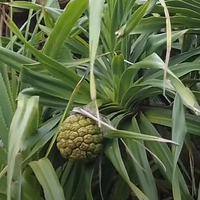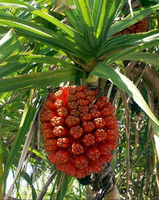Панданус пахучий
| Панданус пахучий | |
|---|---|
 | |
| Научная классификация | |
| Королевство: | Плантае |
| Клад : | Трахеофиты |
| Клад : | Покрытосеменные |
| Клад : | Однодольные |
| Заказ: | Панданалес |
| Семья: | Пандановые |
| Род: | Панданус |
| Разновидность: | P. одорифер |
| Биномиальное имя | |
| Панданус пахучий (Форсск.) Кунтце | |
| Синонимы [1] | |
| |
Pandanus odorifer — ароматный вид однодольных растений семейства Пандановые , произрастающий в Полинезии , Австралии , Южной Азии ( Андаманские острова ) и на Филиппинах , а также в диком виде встречающийся в южной Индии и Бирме . [2] Его также называют ароматной сосной .
Имена
Помимо screw-pine, другие распространённые английские названия дерева включают kewda , fragrant screwpine , umbrella tree и screw tree . [3]
В Индии дерево носит множество названий, многие из которых происходят от санскритского кетаки . [3] на каннаде называется «ಕೇದಿಗೆ» [3] на малаяламе называется pookkaitha , а его цветок известен как thaazhampoo , на тамильском языке он называется kaithai (கைதை) и tāḻai (தாழை), и оба упоминаются в литературе сангама . На телугу это называется могали (మొగలి) . В арабоязычных странах это дерево называют аль-кади ( араб . الكادي ). [4] В Японии дерево называется адан (アダン [阿檀] ) и растет на островах Окинава , а также на островах Токара , Амами Осима и Кикаидзима .
P. odorifer широко произрастает на острове Святого Мартина в Бангладеш , хотя многие из них были уничтожены в результате массовых туристических инициатив.
Описание
It is a small branched, palm-like dioecious tree with a flexuous trunk supported by brace roots. The tree can grow to a height of 4 meters. Leaves grow in clusters at the branch tips, with rosettes of sword-shaped, stiff (leather-like) and spiny bluish-green, fragrant leaves. Leaves are glaucous, 40–70 cm. long. In summer, the tree bears very fragrant flowers, used as perfume. Interestingly, Pandanus lacks a common callose wall around microspore tetrads during pollen development.[5] In Yemen, they are predominantly found alongside flowing streams in the western escarpment foothills; Most common in high rainfall areas.[6] The fragrant male flowers are wrapped in leaves and sold on roadsides and in markets. Only male plants seem to occur in Yemen.[4] Some suggest that it was introduced into Yemen from India where its flowers are used chiefly to make perfume.
Propagation
The tree is propagated vegetatively, by the offshoots of young plants that grow around the base of the trunk, but may also be increased by seed. If by the former method, the offshoots should be cut off and set in sand, at a temperature of 65° to 70°F. The cuttings root slowly, and the plants for a time grow very slowly. The general treatment required for culturing the screw-pine is similar to that of palms. Trees require an abundance of water in summer.[7]
According to Ibn al-'Awwam's 12th-century treatise on agriculture, the kadi is cultivated in a manner similar to that of the Judas tree (Cercis siliquastrum).[8]
Other uses
An aromatic oil called kewra and a fragrant distillate called keorra-ka-arak are extracted from the male flowers.[9] They are almost exclusively used in the form of a watery distillate called kewra water. Its flowers have a sweet, perfumed odor that has a pleasant quality similar to rose flowers, although kewra is considered more fruity. The watered-down distillate is quite diluted; it can be used by the tablespoon, often even by the teaspoon.
The ketaki tree's flower is never used as an offering to the god Shiva. According to Hindu mythology, Shiva cursed the flower that it will never be used to worship him for helping Brahma lie against him, and then to Brahma that he will not be worshipped by people.
On Ishigaki Island, south-west of Okinawa, it is customary to use parts of the plant during Bon festivities as an offering. The soft shoots can also be eaten, although the taste is very astringent and the shoots are considered inedible without blanching them first. When they are properly treated however, the taste is similar to that of bamboo shoots.
Despite the pineapple-like appearance of the fruit and its sweet aroma, it is very fibrous and while being non-toxic, is generally not considered for consumption.
Gallery
- Pandanus odoratissimus on Miyako-jima, Okinawa prefecture
- Adan on Takarajima (Southern Tokara Islands), Kagoshima prefecture.
- Ripe fruit of Pandanus odoratissimus. Iloilo City, The Philippines.
See also
References
- ^ "The Plant List: A Working List of All Plant Species". Retrieved 26 February 2015.
- ^ Nadaf, A.; Zanan, R. (2012), "Biogeography of Indian Pandanaceae", Indian Pandanaceae - an overview, Springer India, pp. 15–28, doi:10.1007/978-81-322-0753-5_3, ISBN 978-81-322-0752-8
- ^ a b c "Kewda". FlowersOfIndia.net. Retrieved 25 July 2016.
- ^ a b J.R.I. Wood, A Handbook of the Yemen Flora, Royal Botanic Gardens, Kew 1997, p. 315 ISBN 1 900347 31 8
- ^ Scott, R. J. (2004-03-12). "Stamen Structure and Function". The Plant Cell Online. 16 (suppl_1): S46 – S60. doi:10.1105/tpc.017012. ISSN 1040-4651. PMC 2643399. PMID 15131249.
- ^ Abdul Wali A. al-Khulaidi, Flora of Yemen, Sustainable Environmental Management Program (YEM/97/100), Republic of Yemen, June 2000, pp. 13, 149.
- ^ L.H. Bailey, Manual of Gardening (2nd edition), New York 1910, Chapter VIII: The Growing of the Ornamental Plants – Instructions of Particular Kinds, s.v. Pandanus.
- ^ Ibn al-'Awwam, Yaḥyá (1864). Le livre de l'agriculture d'Ibn-al-Awam (kitab-al-felahah) (in French). Translated by J.-J. Clement-Mullet. Paris: A. Franck. p. 304 (ch. 7 - Article 35). OCLC 780050566. (p. 304, Article XXXV). For the cultivating method of the Judas tree, see pp. 303–304.
- ^ Adkar PP, Bhaskar VH (22 декабря 2014 г.). «Pandanus odoratissimus (Kewda): обзор этнофармакологии, фитохимии и пищевых аспектов». Adv. Pharmacol. Sci . 2014 (120895): 120895. doi : 10.1155/2014/120895 . PMC 4408760. PMID 25949238 .




